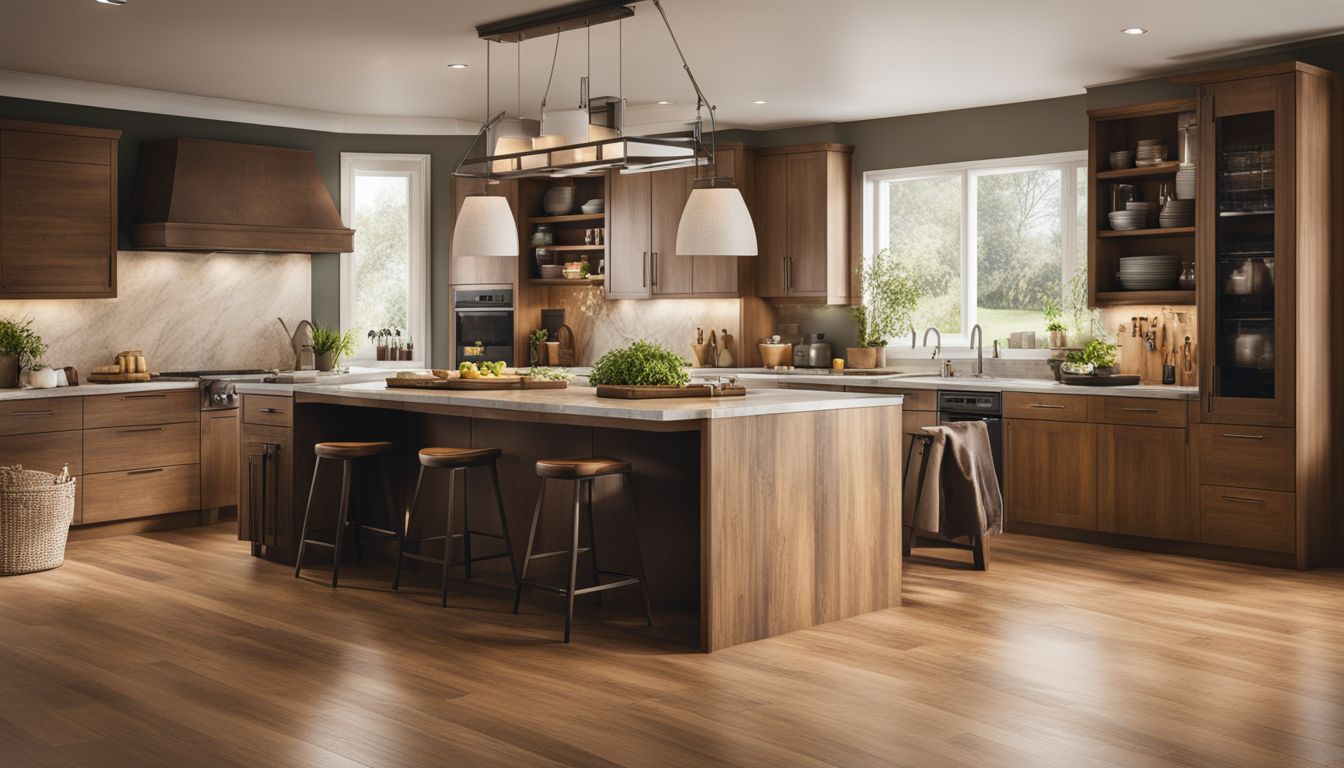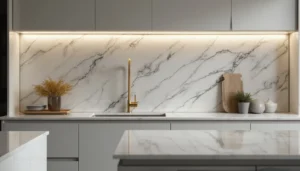Many people want their kitchens to be green. They look for floors that are kind to the earth. But finding the right one can be hard.
You might wonder which options are best for nature and your home.
Good news is, choosing doesn’t have to be a puzzle.
One key fact is: Floors like cork and bamboo suck in carbon. This makes your kitchen cleaner and helps our planet too.
This blog will show you how to pick floors that are strong, good for Earth, and won’t empty your wallet.
Ready? Let’s find the perfect sustainable kitchen flooring options together!
Key Takeaways
- Cork, bamboo, and linoleum are great for kitchens because they’re tough and good for the Earth.
- These floors can keep your home warm or cool, reduce noise, and don’t have bad chemicals.
- Choosing eco – friendly floors means picking ones that last long without hurting the planet.
Overview of Sustainable Kitchen Flooring Options
Picking a floor for your kitchen that’s kind to the planet can be fun. There are green choices like wood from forests managed right, soft cork, tough bamboo, and linseed oil-based floors.
1.Hardwood Floors
Hardwood floors bring warmth and style to any kitchen. They are a classic choice that never goes out of fashion.
Made from trees like oak and maple, these floors last for many years with proper care.
You can even sand and refinish them several times to remove scratches or change the finish.
This makes hardwood a smart option for homeowners who want beauty and durability.
These floors also have an environmental edge because they come from natural, renewable resources.
Trees absorb carbon dioxide, making wood flooring a good pick for those looking to reduce their carbon footprint.
Plus, choosing FSC-certified woodensures the trees were grown in responsibly managed forests. This means your floor is not only durable but also kind on the planet.
2.Cork
Moving from the classic beauty of hardwood floors, cork comes in as an eco-friendly champ. This material is soft underfoot and kind on the environment.
Made from the bark of cork oak trees, this flooring option keeps your kitchen cozy and quiet.
Cork trees don’t get cut down for harvest. Instead, workers strip the bark, which grows back every nine years. This makes cork a renewable resource.
Cork floors are great at keeping your home warm in winter and cool in summer. They also absorb sound, so you won’t hear every step or drop.
Plus, they’re naturally water-resistant and push away bugs that might want to call your kitchen home.
For those worried about indoor pollution, cork floors come with a big plus – they don’t off-gas harmful chemicals like some other materials do.
Reducing pollutants inside your house has never been easier with this natural choice that also adds a unique style to any kitchen space.
3.Bamboo
Bamboo is a great pick for kitchen floors. This plant grows fast, making it a smart choice for people who care about the Earth.
Floors made from bamboo are strong and can last a long time.
They don’t harm the environment much because bamboo absorbs carbon dioxide, which helps keep our air clean.
Plus, these floors are not hard to take care of and they look nice.
Using bamboo means you’re choosing materials that don’t add to pollution indoors.
These floors don’t have harmful chemicals like formaldehyde, common in other types of flooring.
So, your kitchen stays safe and healthy for everyone in your home.
Next up, let’s talk about Linoleum – another eco-friendly option for your space.
4.Linoleum
Linoleum is a cool choice for your kitchen floor. It’s made from natural stuff like flaxseed oil, cork dust, and tree resins.
This mix makes linoleum biodegradable and good for the earth.
Plus, it doesn’t give off bad airs—those volatile organic compoundsthat can mess with your indoor air quality.
This flooring has been around since the 1800s, but don’t think it’s out of style. You can find it in lots of colors and designs today.
It’s tough too, ready to take on spills and drops in busy kitchens.
Cleaning is easy; just sweep or mop without worrying about harming the planet or your health. And if you ever want to change things up?
Linoleum can be recycled, making your eco-friendly circle complete.
Selecting the Best Sustainable Kitchen Flooring
Picking the right eco-friendly floor is all about balance.
You have to weigh things like how long it will last and if it’s good for the planet.
You also think about cost. So, keep looking to find out which green option might be best for your kitchen!
Considerations for Durability and Function
Kitchen floors must last. They face spilled water, dropped pots, and heavy traffic. You want a floor that stands up to this use.
Cork and bamboo are tough choices.
They can take a beating from cooking spills and still look good.
Floors also need to function well in your daily life. If you cook a lot, think about how the floor feels underfoot.
Some materials like cork are kinder to your feet during long cook times.
Also, check if the material fits with underfloor heatingif you plan to use that in colder months.
Choose wisely for both toughness and how it makes your kitchen work better for you.
Environmental Impact
Flooring choices have a big effect on the planet. Materials like cork, bamboo, and recycled objects cut down indoor pollution and health issues from toxic stuff.
They’re made of natural, renewable resources.
This is good for the air inside homes and the earth outside. Cork floors come from trees that can grow back their bark.
Bamboo grows fast, making it a smart pick for green flooring.
Recycled materials make new floors without needing more raw stuff from nature.
Some options absorb carbon too, which helps fight climate change.
Floors like these are not only strong but also keep our planet healthier longer.
Eco-friendly means picking floors that work well in kitchens and don’t harm the earth.
Next up: think about how much you want to spend on your new kitchen floor.
FAQs
1. What makes a kitchen floor sustainable?
A kitchen floor is sustainable if it’s made from natural materials, like cork or bamboo, that don’t harm the earth.
It should also come from places that take care of forests, like the Forest Stewardship Council does.
2. Can recycled stuff be good for floors?
Yes! Floors can be made from recycled things like glass tiles or cotton. This helps use less new stuff and keeps old stuff out of trash piles.
3. Are all wood floors okay for the planet?
Not all of them. But hardwood flooring and engineered hardwood are better if they’re made in ways that don’t hurt forests too much.
4. What should I avoid in eco-friendly flooring?
Try to stay away from vinyl flooring and anything with VOCs (short for volatile organic compounds). These can make the air inside not so good to breathe.
5. How do I pick a non-toxic floor?
Look for floors without harmful chemicals, like marmoleum or ceramic tiles. They’re safer for you and the planet.
6. Can my old floor be used again somehow?
Sure! Some floors, like terrazzo, use bits of old glass or stone mixed in new ways. Or find someone who can reuse your old stuff instead of throwing it away.
Conclusion
Picking the right eco-friendly floor for your kitchen matters a lot. Floors like cork, bamboo, and linoleum bring nature inside.
They last long and are kind to the planet. This choice cuts down indoor pollution and creates a safer space for everyone in your home.
So, go on—make a smart pick for your kitchen that’s good for both Earth and your feet!






